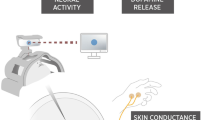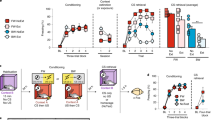Abstract
Studies of reconsolidation, in which retrieved memories are altered and restored, offer an approach for exploring the associative structure of fear memory. We found that exposure to the unconditioned stimulus initiates an unconditioned stimulus−specific reconsolidation of learned fear in rats that depended on the amygdala. Thus, specific features of the unconditioned stimulus appear to be encoded in the amygdala as part of fear memories stored there.
This is a preview of subscription content, access via your institution
Access options
Subscribe to this journal
Receive 12 print issues and online access
$209.00 per year
only $17.42 per issue
Buy this article
- Purchase on Springer Link
- Instant access to full article PDF
Prices may be subject to local taxes which are calculated during checkout


Similar content being viewed by others
References
Sara, S.J. Learn. Mem. 7, 73–84 (2000).
Nader, K., Schafe, G.E. & LeDoux, J.E. Nature 406, 722–726 (2000).
Tronson, N.C. & Taylor, J.R. Nat. Rev. Neurosci. 8, 262–275 (2007).
LeDoux, J.E. Annu. Rev. Neurosci. 23, 155–184 (2000).
Fanselow, M.S. & Poulos, A.M. Annu. Rev. Psychol. 56, 207–234 (2005).
Davis, M. Annu. Rev. Neurosci. 15, 353–375 (1992).
Everitt, B.J., Cardinal, R.N., Parkinson, J.A. & Robbins, T.W. Ann. NY Acad. Sci. 985, 233–250 (2003).
Maren, S. Neuron 47, 783–786 (2005).
Doyère, V., Dębiec, J., Monfils, M.H., Schafe, G.E. & LeDoux, J.E. Nat. Neurosci. 10, 414–416 (2007).
Dębiec, J., Doyère, V., Nader, K. & LeDoux, J.E. Proc. Natl. Acad. Sci. USA 103, 3428–3433 (2006).
Spear, N.E. & Parsons, P. in Coding Processes in Animal Memory (eds. Davies, R. & Roberts, W.) 135–165 (Erlbaum, Hillsdale, New Jersey, 1976).
Miller, R.R. & Springer, A.D. Physiol. Behav. 8, 645–651 (1972).
Milekic, M.H., Brown, S.D., Castellini, C. & Alberini, C.M. J. Neurosci. 26, 3010–3020 (2006).
Acknowledgements
The authors thank C. Farb and J. Erlich for their advice and S. Kadakia for her technical assistance. This research was supported by grants R01 MH046516, R37 MH038774 and P50 MH058911 to J.E.L. and a National Science Foundation–Centre National de la Recherche Scientifique (NSF-CNRS) International Cooperative grant, a CNRS Project International de la Coopération Scientifique grant and a CNRS-UPS-NYU collaboration grant EmoTime to V.D. and J.E.L. L.D.-M. was supported by a Fulbright/Spanish Ministry of Education postdoctoral fellowship.
Author information
Authors and Affiliations
Contributions
J.D. designed and conducted the experiments, analyzed the data, interpreted the results, wrote the initial manuscript and was involved in the revision process. L.D.-M. was involved in conducting experiments, analyzing the data, interpreting the results and writing and revising the manuscript. D.E.A.B. conducted all the statistical data analysis and was involved in designing the experiments, interpreting the results and writing and revising the manuscript. V.D. was involved in designing and conducting the experiments, interpreting the results and writing and revising the manuscript. J.E.L. was involved in the design of the studies, the interpretation of the results and the preparation and revision of the manuscript.
Corresponding author
Ethics declarations
Competing interests
The authors declare no competing financial interests.
Supplementary information
Supplementary Text and Figures
Supplementary Figures 1–6 and Supplementary Methods (PDF 1786 kb)
Rights and permissions
About this article
Cite this article
Dębiec, J., Díaz-Mataix, L., Bush, D. et al. The amygdala encodes specific sensory features of an aversive reinforcer. Nat Neurosci 13, 536–537 (2010). https://doi.org/10.1038/nn.2520
Received:
Accepted:
Published:
Issue Date:
DOI: https://doi.org/10.1038/nn.2520
This article is cited by
-
Comparative metabolic profiling of posterior parietal cortex, amygdala, and hippocampus in conditioned fear memory
Molecular Brain (2021)
-
Propranolol-induced inhibition of unconditioned stimulus-reactivated fear memory prevents the return of fear in humans
Translational Psychiatry (2020)
-
Molecular and circuit mechanisms regulating cocaine memory
Cellular and Molecular Life Sciences (2020)
-
Garcinol Blocks the Reconsolidation of Multiple Cocaine-Paired Cues after a Single Cocaine-Reactivation Session
Neuropsychopharmacology (2017)
-
A novel UCS memory retrieval-extinction procedure to inhibit relapse to drug seeking
Nature Communications (2015)



